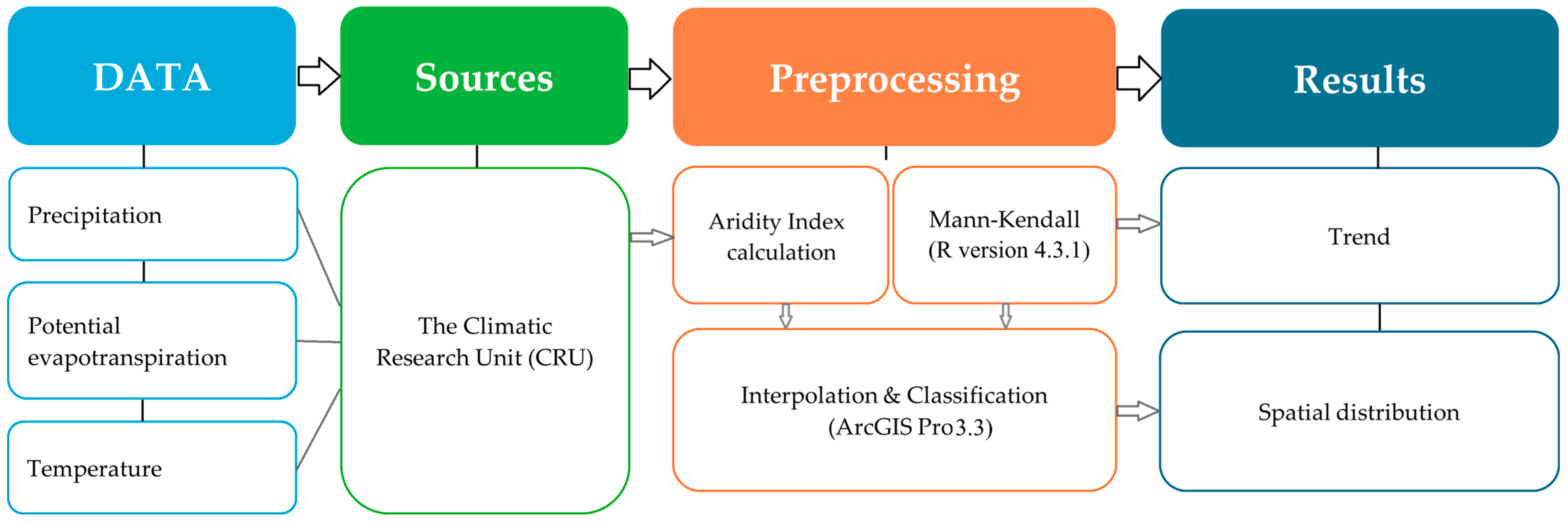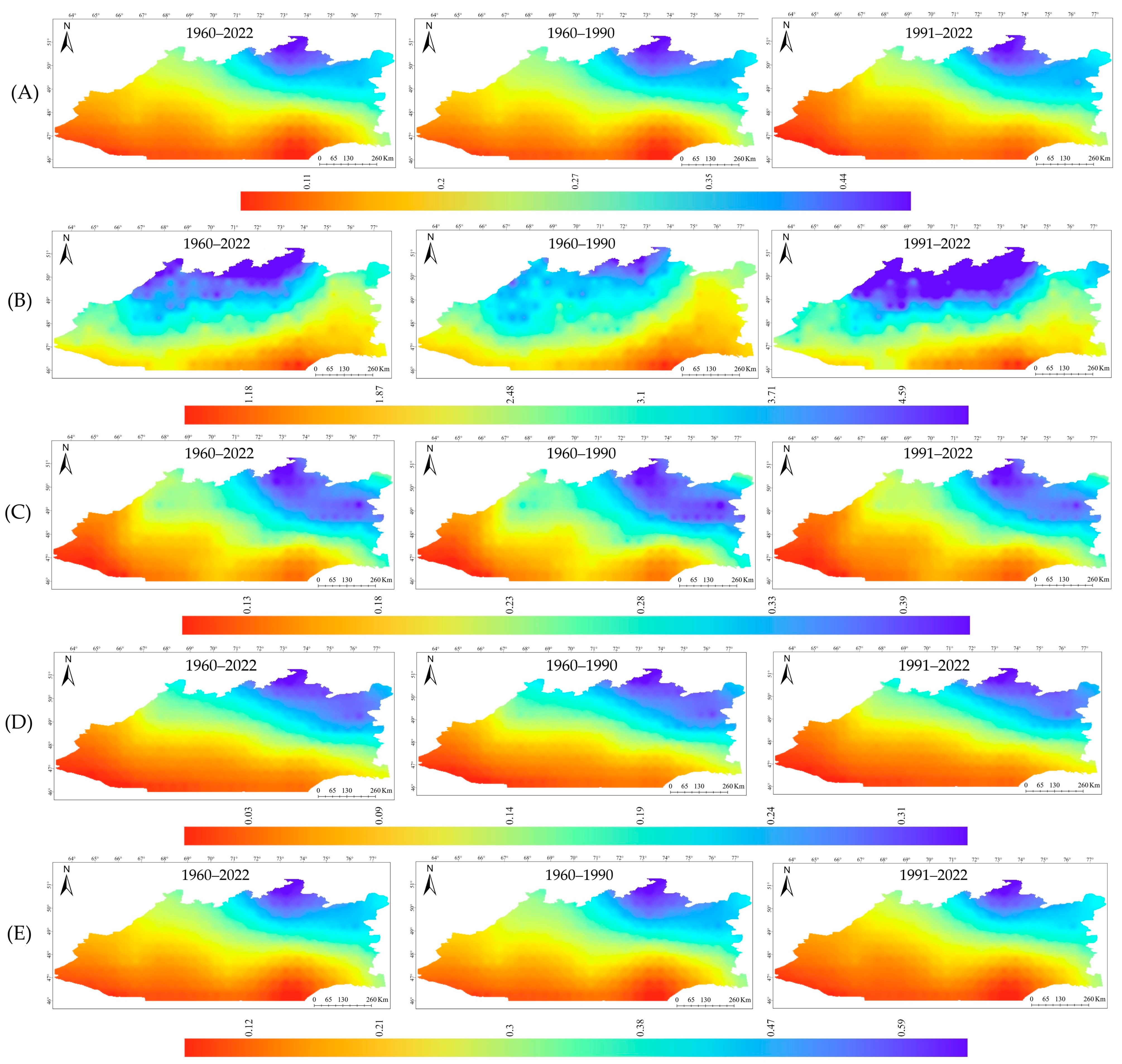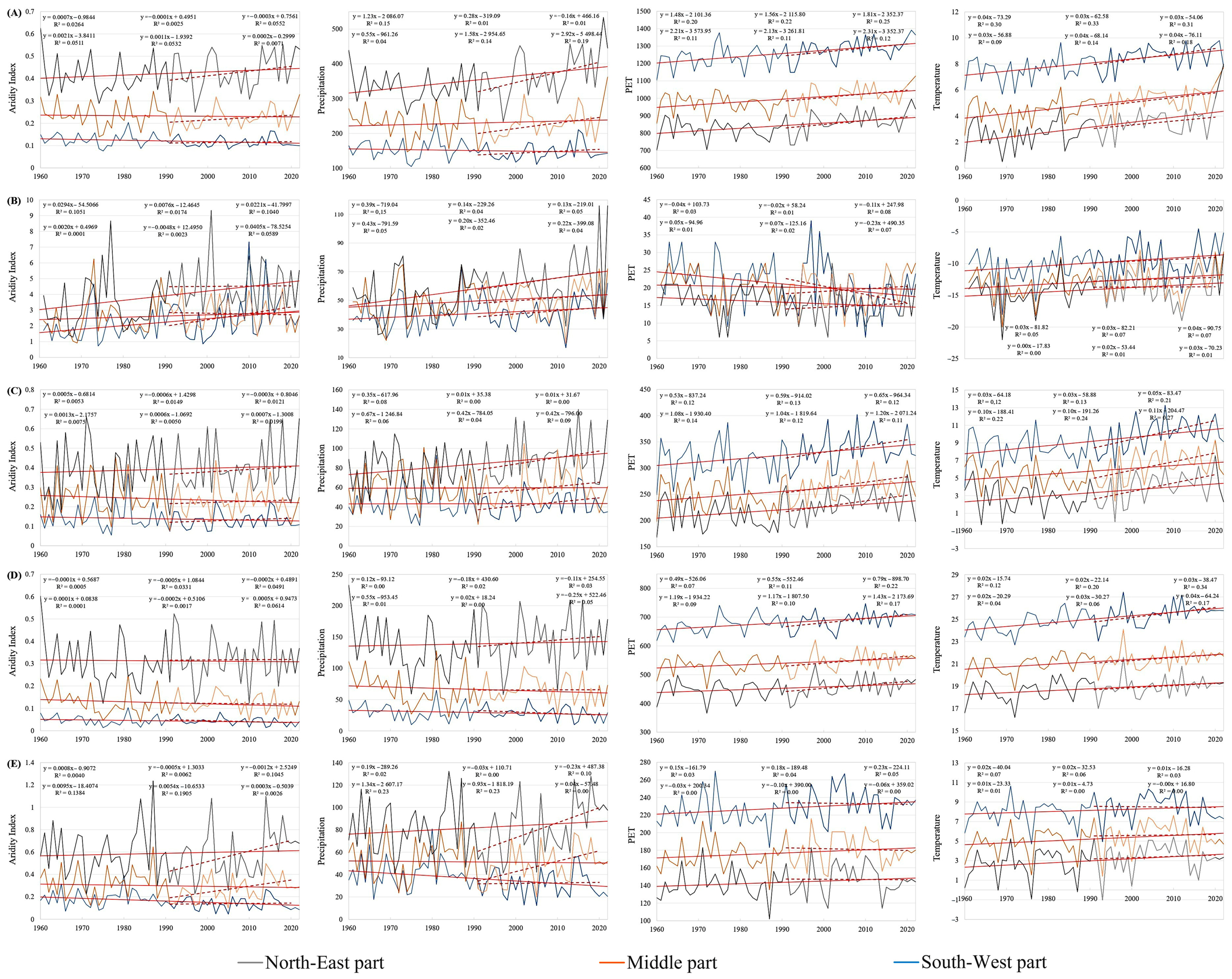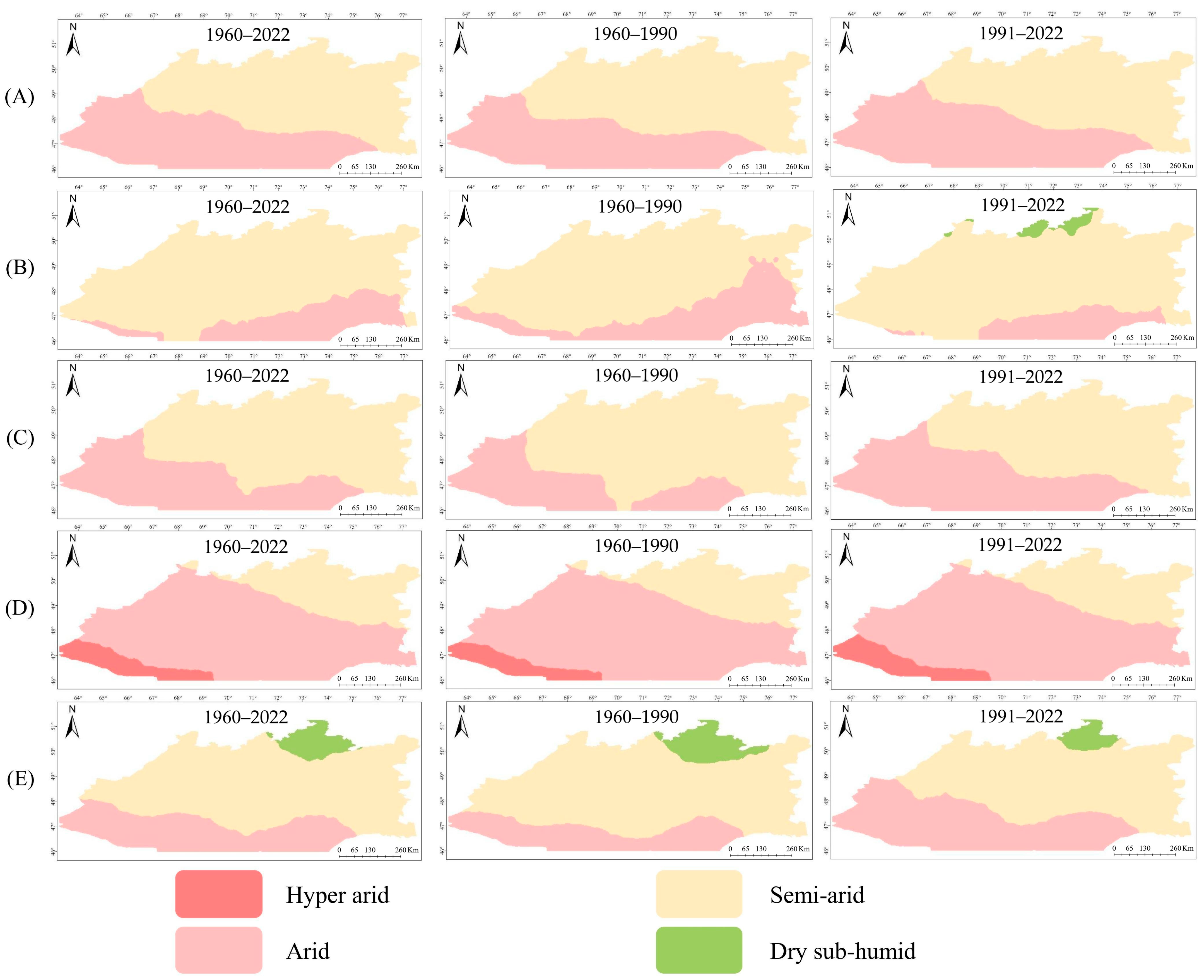Spatiotemporal Dynamics of the Aridity Index in Central Kazakhstan
Abstract
1. Introduction
2. Study Area
3. Data Sources
4. Methods
4.1. Aridity Index
4.2. Mann–Kendall Test
5. Results
5.1. Spatial Change in Average Aridity Index
5.2. Temporal Characteristics of Aridity Index Changes and Trends
5.3. Spatial Distribution Characteristics of Aridity Index Climate Zones
| Periods | Type | Areal Extent Changes, in % | ||||
|---|---|---|---|---|---|---|
| Annual | Winter | Spring | Summer | Autumn | ||
| 1960–2020 | Hyper-arid | 0 | 0 | 0 | 8 | 0 |
| Arid | 43 | 20 | 37 | 69 | 28 | |
| Semi-arid | 57 | 80 | 63 | 23 | 67 | |
| Dry sub-humid | 0 | 0 | 0 | 0 | 5 | |
| 1960–1990 | Hyper-arid | 0 | 0 | 0 | 7 | 0 |
| Arid | 40 | 28 | 29 | 70 | 21 | |
| Semi-arid | 60 | 72 | 71 | 23 | 72 | |
| Dry sub-humid | 0 | 0 | 0 | 0 | 7 | |
| 1990–2020 | Hyper-arid | 0 | 0 | 0 | 8 | 0 |
| Arid | 47 | 13 | 44 | 69 | 38 | |
| Semi-arid | 53 | 84 | 56 | 23 | 59 | |
| Dry sub-humid | 0 | 2 | 0 | 0 | 3 | |
6. Discussion
- -
- Increased aridification across Kazakhstan, with northern regions transitioning to semi-arid zones and other areas shifting to fully arid conditions.
- -
- Vertical displacement of natural zone boundaries, altering altitudinal ecosystem distributions.
- -
- Prolonged and intensified droughts, dry winds, and extreme temperature events.
- -
- A 50–70% reduction in summer precipitation, leading to decreased agricultural yields.
- -
- A 30–90% decline in natural pasture productivity, threatening pastoral economies.
7. Conclusions
Author Contributions
Funding
Institutional Review Board Statement
Informed Consent Statement
Data Availability Statement
Conflicts of Interest
References
- Vicente-Serrano, S.M.; Peña-Angulo, D.; Beguería, S.; Domínguez-Castro, F.; Tomás-Burguera, M.; Noguera, I.; Gimeno-Sotelo, L.; El Kenawy, A. Global Drought Trends and Future Projections. Philos. Trans. R. Soc. A Math. Phys. Eng. Sci. 2022, 380. [Google Scholar] [CrossRef]
- Rajkhowa, S.; Sarma, J. Climate Change and Flood Risk, Global Climate Change. In Global Climate Change; Elsevier: Amsterdam, The Netherlands, 2021; pp. 321–339. [Google Scholar]
- Gampe, D.; Zscheischler, J.; Reichstein, M.; O’Sullivan, M.; Smith, W.K.; Sitch, S.; Buermann, W. Increasing Impact of Warm Droughts on Northern Ecosystem Productivity over Recent Decades. Nat. Clim. Chang. 2021, 11, 772–779. [Google Scholar] [CrossRef]
- Huang, J.; Mondal, S.K.; Zhai, J.; Fischer, T.; Wang, Y.; Su, B.; Wang, G.; Gao, M.; Jiang, S.; Tao, H.; et al. Intensity-Area-Duration-Based Drought Analysis under 1.5 °C–4.0 °C Warming Using CMIP6 over a Climate Hotspot in South Asia. J. Clean. Prod. 2022, 345, 131106. [Google Scholar] [CrossRef]
- Millennium Ecosystem Assessment (MEA). Ecosystems and Human Well-Being; Island Press: Washington, DC, USA, 2005; Volume 5. [Google Scholar]
- Wilhite, D.A.; Buchanan-Smith, M. Drought as Hazard: Understanding the Natural and Social Context. In Drought and Water Crises; CRC Press: Boca Raton, FL, USA, 2017; p. 18. [Google Scholar]
- Zhu, Y.; Yang, P.; Xia, J.; Huang, H.; Chen, Y.; Li, Z.; Sun, K.; Song, J.; Shi, X.; Lu, X. Drought Propagation and Its Driving Forces in Central Asia under Climate Change. J. Hydrol. 2024, 636, 131260. [Google Scholar] [CrossRef]
- Liu, Y.; Shan, F.; Yue, H.; Wang, X.; Fan, Y. Global Analysis of the Correlation and Propagation among Meteorological, Agricultural, Surface Water, and Groundwater Droughts. J. Environ. Manag. 2023, 333, 117460. [Google Scholar] [CrossRef]
- Kim, S.W.; Jung, D.; Choung, Y.-J. Development of a Multiple Linear Regression Model for Meteorological Drought Index Estimation Based on Landsat Satellite Imagery. Water 2020, 12, 3393. [Google Scholar] [CrossRef]
- Li, M.; Yao, J.; Zheng, J. Spatio-Temporal Changes in Atmospheric Aridity over the Arid Region of Central Asia during 1979–2019. Ecol. Indic. 2024, 169, 112814. [Google Scholar] [CrossRef]
- Ullah, S.; You, Q.; Sachindra, D.A.; Nowosad, M.; Ullah, W.; Bhatti, A.S.; Jin, Z.; Ali, A. Spatiotemporal Changes in Global Aridity in Terms of Multiple Aridity Indices: An Assessment Based on the CRU Data. Atmos. Res. 2022, 268, 105998. [Google Scholar] [CrossRef]
- Yao, J.; Chen, Y.; Chen, J.; Zhao, Y.; Tuoliewubieke, D.; Li, J.; Yang, L.; Mao, W. Intensification of Extreme Precipitation in Arid Central Asia. J. Hydrol. 2021, 598, 125760. [Google Scholar] [CrossRef]
- Asadi Zarch, M.A.; Sivakumar, B.; Sharma, A. Assessment of Global Aridity Change. J. Hydrol. 2015, 520, 300–313. [Google Scholar] [CrossRef]
- Park, C.-E.; Jeong, S.-J.; Joshi, M.; Osborn, T.J.; Ho, C.-H.; Piao, S.; Chen, D.; Liu, J.; Yang, H.; Park, H.; et al. Keeping Global Warming within 1.5 °C Constrains Emergence of Aridification. Nat. Clim. Chang. 2018, 8, 70–74. [Google Scholar] [CrossRef]
- Lioubimtseva, E.; Cole, R.; Adams, J.M.; Kapustin, G. Impacts of Climate and Land-Cover Changes in Arid Lands of Central Asia. J. Arid Environ. 2005, 62, 285–308. [Google Scholar] [CrossRef]
- De Martonne, E. Aréisme et Indice d’aridité; Comptes Rendus de L’Academy of Science: Paris, France, 1926. [Google Scholar]
- Erinç, S. An Attempt on Precipitation Efficiency and a New Index; Instanbul University Institute Release; Baha Press: Istanbul, Turkey, 1965. [Google Scholar]
- Paltineanu, C.; Mihailescu, I.F.; Seceleanu, I.; Dragota, C.; Vasenciuc, F. Using Aridity Indices to Describe Some Climate and Soil Features in Eastern Europe: A Romanian Case Study. Theor. Appl. Climatol. 2007, 90, 263–274. [Google Scholar] [CrossRef]
- Koffi, D.; Komla, G. Trend Analysis in Reference Evapotranspiration and Aridity Index in the Context of Climate Change in Togo. J. Water Clim. Chang. 2015, 6, 848–864. [Google Scholar] [CrossRef]
- Fu, Q.; Feng, S. Responses of Terrestrial Aridity to Global Warming. J. Geophys. Res. Atmos. 2014, 119, 7863–7875. [Google Scholar] [CrossRef]
- McDonald, R.I.; Douglas, I.; Revenga, C.; Hale, R.; Grimm, N.; Grönwall, J.; Fekete, B. Global Urban Growth and the Geography of Water Availability, Quality, and Delivery. Ambio 2011, 40, 437–446. [Google Scholar] [CrossRef] [PubMed]
- Kimura, R.; Moriyama, M. Recent Trends of Annual Aridity Indices and Classification of Arid Regions with Satellite-Based Aridity Indices. Remote Sens. Earth Syst. Sci. 2019, 2, 88–95. [Google Scholar] [CrossRef]
- Liu, X.; Zhang, D.; Luo, Y.; Liu, C. Spatial and Temporal Changes in Aridity Index in Northwest China: 1960 to 2010. Theor. Appl. Climatol. 2013, 112, 307–316. [Google Scholar] [CrossRef]
- dos Santos, J.C.; Lyra, G.B.; Abreu, M.C.; de Oliveira-Júnior, J.F.; Bohn, L.; Cunha-Zeri, G.; Zeri, M. Aridity Indices to Assess Desertification Susceptibility: A Methodological Approach Using Gridded Climate Data and Cartographic Modeling. Nat. Hazards 2022, 111, 2531–2558. [Google Scholar] [CrossRef]
- Cowie, A.L.; Penman, T.D.; Gorissen, L.; Winslow, M.D.; Lehmann, J.; Tyrrell, T.D.; Twomlow, S.; Wilkes, A.; Lal, R.; Jones, J.W.; et al. Towards Sustainable Land Management in the Drylands: Scientific Connections in Monitoring and Assessing Dryland Degradation, Climate Change and Biodiversity. L. Degrad. Dev. 2011, 22, 248–260. [Google Scholar] [CrossRef]
- IPCC. Climate Change 2021: The Physical Science Basis; Contribution of Working Group I to the Sixth Assessment Report of the Intergovernmental Panel on Climate Change; Masson-Delmotte, V., Zhai, P., Pirani, A., Connors, S.L., Péan, C., Berger, S., Caud, N., Chen, Y., Goldfarb, L., Gomis, M.I., et al., Eds.; Cambridge University Press: Cambridge, UK; New York, NY, USA, 2021; p. 2391. [Google Scholar] [CrossRef]
- Karatayev, M.; Clarke, M.; Salnikov, V.; Bekseitova, R.; Nizamova, M. Monitoring Climate Change, Drought Conditions and Wheat Production in Eurasia: The Case Study of Kazakhstan. Heliyon 2022, 8, e08660. [Google Scholar] [CrossRef]
- Hu, Y.; Han, Y.; Zhang, Y. Land Desertification and Its Influencing Factors in Kazakhstan. J. Arid Environ. 2020, 180, 104203. [Google Scholar] [CrossRef]
- Hu, Y.; Hu, Y. Land Cover Changes and Their Driving Mechanisms in Central Asia from 2001 to 2017 Supported by Google Earth Engine. Remote Sens. 2019, 11, 554. [Google Scholar] [CrossRef]
- Li, Z.; Chen, Y.; Li, W.; Deng, H.; Fang, G. Potential Impacts of Climate Change on Vegetation Dynamics in Central Asia. J. Geophys. Res. Atmos. 2015, 120, 12345–12356. [Google Scholar] [CrossRef]
- Han, W.; Zheng, J.; Guan, J.; Liu, Y.; Liu, L.; Han, C.; Li, J.; Li, C.; Tian, R.; Mao, X. A Greater Negative Impact of Future Climate Change on Vegetation in Central Asia: Evidence from Trajectory/Pattern Analysis. Environ. Res. 2024, 262, 119898. [Google Scholar] [CrossRef]
- Russell, A.; Ghalaieny, M.; Gazdiyeva, B.; Zhumabayeva, S.; Kurmanbayeva, A.; Akhmetov, K.K.; Mukanov, Y.; McCann, M.; Ali, M.; Tucker, A.; et al. A Spatial Survey of Environmental Indicators for Kazakhstan: An Examination of Current Conditions and Future Needs. Int. J. Environ. Res. 2018, 12, 735–748. [Google Scholar] [CrossRef]
- Kuralbayeva, R.; Aitmukhanbetova, D.; Itekeyeva, G.; Kuatpekova, A.; Abdikulova, P. Innovative Methods of Organising the Work of the AIC in Market Conditions (World Experience and Kazakhstan). Sci. Horizons 2023, 26, 158–168. [Google Scholar] [CrossRef]
- Zhumabaev, A.; Schwedhelm, H.; Marti, B.; Ragettli, S.; Siegfried, T. Water Tales from Turkistan: Challenges and Opportunities for the Badam-Sayram Water System under a Changing Climate. Cent. Asian J. Water Res. 2024, 10, 1–25. [Google Scholar] [CrossRef]
- Hu, Q.; Han, Z. Northward Expansion of Desert Climate in Central Asia in Recent Decades. Geophys. Res. Lett. 2022, 49. [Google Scholar] [CrossRef]
- Guo, L.; Xia, Z. Temperature and Precipitation Long-Term Trends and Variations in the Ili-Balkhash Basin. Theor. Appl. Climatol. 2014, 115, 219–229. [Google Scholar] [CrossRef]
- UNDP; UNDP Kazakhstan. Transforming Water Management in Kazakhstan: A Core Investment in Resilience. Available online: https://www.undp.org/kazakhstan/stories/transforming-water-management-kazakhstan-core-investment-resilience (accessed on 28 April 2025).
- Tokbergenova, A.; Nyussupova, G.; Arslan, M.; Kiyassova, S.K.L. Causes and Impacts of Land Degradation and Desertification: Case Study from Kazakhstan. In Vegetation of Central Asia and Environs; Springer: Berlin/Heidelberg, Germany, 2018; pp. 291–302. [Google Scholar] [CrossRef]
- Akhmetova, S.T.; Rodrigo, J.I.; Duskaev, K.K. Analysis of Atmospheric Aridity in the Territory of Almaty Region in the Conditions of Modern Climate Change. J. Geogr. Environ. Manag. 2019, 54, 49–59. [Google Scholar] [CrossRef]
- Zheleznova, I.; Gushchina, D.; Meiramov, Z.; Olchev, A. Temporal and Spatial Variability of Dryness Conditions in Kazakhstan during 1979–2021 Based on Reanalysis Data. Climate 2022, 10, 144. [Google Scholar] [CrossRef]
- Li, S.; He, S.; Xu, Z.; Liu, Y.; von Bloh, W. Desertification Process and Its Effects on Vegetation Carbon Sources and Sinks Vary under Different Aridity Stress in Central Asia during 1990–2020. CATENA 2023, 221, 106767. [Google Scholar] [CrossRef]
- Sembayeva, Z.; Mussina, L.; Kazbek, M.; Dosmaganbetov, A.; Xenarios, S. Sustainable Land Use Resources in Droughtprone Regions of Kazahstan and Implications for the Wider Central Asia Region. In Resilience and Economic Growth in Times of High Uncertainty; CAREC: Almaty, Kazakhstan, 2023; pp. 340–400. Available online: https://www.carecinstitute.org/publications/resilience-and-economic-growth-in-times-of-high-uncertainty/ (accessed on 21 April 2025).
- Harris, I.; Osborn, T.J.; Jones, P.; Lister, D. Version 4 of the CRU TS Monthly High-Resolution Gridded Multivariate Climate Dataset. Sci. Data 2020, 7, 109. [Google Scholar] [CrossRef]
- Zhu, X.; Zhang, M.; Wang, S.; Qiang, F.; Zeng, T.; Ren, Z.; Dong, L. Comparison of Monthly Precipitation Derived from High-Resolution Gridded Datasets in Arid Xinjiang, Central Asia. Quat. Int. 2015, 358, 160–170. [Google Scholar] [CrossRef]
- Sun, Q.; Miao, C.; Duan, Q.; Ashouri, H.; Sorooshian, S.; Hsu, K. A Review of Global Precipitation Data Sets: Data Sources, Estimation, and Intercomparisons. Rev. Geophys. 2018, 56, 79–107. [Google Scholar] [CrossRef]
- Elagib, N.A.; Ali, M.M.A.; Schneider, K. Evaluation and Bias Correction of CRU TS4.05 Potential Evapotranspiration across Vast Environments with Limited Data. Atmos. Res. 2024, 299, 107194. [Google Scholar] [CrossRef]
- Oduro, C.; Shuoben, B.; Ayugi, B.; Beibei, L.; Babaousmail, H.; Sarfo, I.; Ullah, S.; Ngoma, H. Observed and Coupled Model Intercomparison Project 6 Multimodel Simulated Changes in Near-surface Temperature Properties over Ghana during the 20th Century. Int. J. Climatol. 2022, 42, 3681–3701. [Google Scholar] [CrossRef]
- Ahmed, K.; Shahid, S.; Wang, X.; Nawaz, N.; Khan, N. Spatiotemporal Changes in Aridity of Pakistan during 1901–2016. Hydrol. Earth Syst. Sci. 2019, 23, 3081–3096. [Google Scholar] [CrossRef]
- Ahmed, R.; Shamim, T.; Bansal, J.K.; Rather, A.F.; Javaid, S.; Wani, G.F.; Malik, I.H.; Ahmed, P.; Jain, S.K.; Imdad, K.; et al. Assessing Climate Trends in the Northwestern Himalayas: A Comprehensive Analysis of High-Resolution Gridded and Observed Datasets. Geomat. Nat. Hazards Risk 2024, 15, 2401994. [Google Scholar] [CrossRef]
- Lickley, M.; Solomon, S. Drivers, Timing and Some Impacts of Global Aridity Change. Environ. Res. Lett. 2018, 13, 104010. [Google Scholar] [CrossRef]
- Mann, H.B. Non-Parametric Test against Trend. Econometrica 1945, 13, 245–259. [Google Scholar] [CrossRef]
- Yue, S.; Pilon, P.; Cavadias, G. Power of the Mann–Kendall and Spearman’s Rho Tests for Detecting Monotonic Trends in Hydrological Series. J. Hydrol. 2002, 259, 254–271. [Google Scholar] [CrossRef]
- Tabari, H.; Aghajanloo, M. Temporal Pattern of Aridity Index in Iran with Considering Precipitation and Evapotranspiration Trends. Int. J. Climatol. 2013, 33, 396–409. [Google Scholar] [CrossRef]
- Jiang, L.; Liu, B.; Guo, H.; Yuan, Y.; Liu, W.; Jiapaer, G. Assessing Vegetation Resilience and Vulnerability to Drought Events in Central Asia. J. Hydrol. 2024, 634, 131012. [Google Scholar] [CrossRef]
- Deng, H.; Yin, Y.; Han, X. Vulnerability of Vegetation Activities to Drought in Central Asia. Environ. Res. Lett. 2020, 15, 084005. [Google Scholar] [CrossRef]
- Vitkovskaya, I.; Batyrbayeva, M.; Berdigulov, N.; Mombekova, D. Prospects for Drought Detection and Monitoring Using Long-Term Vegetation Indices Series from Satellite Data in Kazakhstan. Land 2024, 13, 2225. [Google Scholar] [CrossRef]
- Salnikov, V.; Talanov, Y.; Polyakova, S.; Assylbekova, A.; Kauazov, A.; Bultekov, N.; Musralinova, G.; Kissebayev, D.; Beldeubayev, Y. An Assessment of the Present Trends in Temperature and Precipitation Extremes in Kazakhstan. Climate 2023, 11, 33. [Google Scholar] [CrossRef]
- Zhou, J.; Jiang, T.; Wang, Y.; Su, B.; Tao, H.; Qin, J.; Zhai, J. Spatiotemporal Variations of Aridity Index over the Belt and Road Region under the 1.5 °C and 2.0 °C Warming Scenarios. J. Geogr. Sci. 2020, 30, 37–52. [Google Scholar] [CrossRef]
- Yan, X.; Zhang, Q.; Ren, X.; Wang, X.; Yan, X.; Li, X.; Wang, L.; Bao, L. Climatic Change Characteristics towards the “Warming–Wetting” Trend in the Pan-Central-Asia Arid Region. Atmosphere 2022, 13, 467. [Google Scholar] [CrossRef]
- Farooq, I.; Shah, A.R.; Sahana, M.; Ehsan, M.A. Assessment of Drought Conditions Over Different Climate Zones of Kazakhstan Using Standardised Precipitation Evapotranspiration Index. Earth Syst. Environ. 2023, 7, 283–296. [Google Scholar] [CrossRef]
- Budanov, N.U. Degradation of Land Resources of Kazakhstan. In Proceedings of the International Science-Practice Conference “Geography and Geoecology: Science, Practice, and Education”; Moscow Region State University Publishing House: Moscow, Russia, 2016; pp. 31–36. [Google Scholar]
- Shmelev, S.E.; Salnikov, V.; Turulina, G.; Polyakova, S.; Tazhibayeva, T.; Schnitzler, T.; Shmeleva, I.A. Climate Change and Food Security: The Impact of Some Key Variables on Wheat Yield in Kazakhstan. Sustainability 2021, 13, 8583. [Google Scholar] [CrossRef]
- Zou, S.; Abuduwaili, J.; Ding, J.; Duan, W.; De Maeyer, P.; van de Voorde, T. Description and Attribution Analysis of the 2017 Spring Anomalous High Temperature Causing Floods in Kazakhstan. J. Meteorol. Soc. Japan. Ser. II 2020, 98, 1353–1368. [Google Scholar] [CrossRef]
- Bayer-Altın, T.; Sadykova, D.; Türkeş, M. Evolution of Long-Term Trends and Variability in Air Temperatures of Kazakhstan for the Period 1963–2020. Theor. Appl. Climatol. 2024, 155, 541–566. [Google Scholar] [CrossRef]
- Cherednichenko, A.V.; Cherednichenko, A.V.; Cherednichenko, V.S. Climatic Fluctuations in Temperature and Precipitation in Northern Kazakhstan. Proc. Vor. State Univ. Ser. Geogr. Geoecology 2019, 2, 17–31. (In Russian) [Google Scholar]
- Fekete, B.M.; Vörösmarty, C.J.; Roads, J.O.; Willmott, C.J. Uncertainties in Precipitation and Their Impacts on Runoff Estimates. J. Clim. 2004, 17, 294–304. [Google Scholar] [CrossRef]
- Nicholson, S.E. The West African Sahel: A Review of Recent Studies on the Rainfall Regime and Its Interannual Variability. ISRN Meteorol. 2013, 2013, 1–32. [Google Scholar] [CrossRef]
- Cook, B.I.; Ault, T.R.; Smerdon, J.E. Unprecedented 21st Century Drought Risk in the American Southwest and Central Plains. Sci. Adv. 2015, 1, e1400082. [Google Scholar] [CrossRef]
- Timbal, B.; Drosdowsky, W. The Relationship between the Decline of Southeastern Australian Rainfall and the Strengthening of the Subtropical Ridge. Int. J. Climatol. 2013, 33, 1021–1034. [Google Scholar] [CrossRef]
- CAREC Analysis of Climate Change Adaptation Activities in Central Asia: Needs, Recommendations, Practices. Available online: https://carececo.org/upload/27.pdf (accessed on 21 April 2025).
- Luković, J.; Bajat, B.; Blagojević, D.; Kilibarda, M. Spatial Pattern of Recent Rainfall Trends in Serbia (1961–2009). Reg. Environ. Chang. 2014, 14, 1789–1799. [Google Scholar] [CrossRef]





| Parts of Region | Para- Meters | Z Value | |||||||||
|---|---|---|---|---|---|---|---|---|---|---|---|
| Annual | Winter | Spring | Summer | Autumn | |||||||
| 1960–2022 | 1991–2022 | 1960–2022 | 1991–2022 | 1960–2022 | 1991–2022 | 1960–2022 | 1991–2022 | 1960–2022 | 1991–2022 | ||
| Southern | P | −1.05 | 0.92 | 1.71 | 1.04 | 0.62 | 1.75 | −0.96 | −0.48 | −1.97 * | −0.11 |
| PET | 3.64 * | 1.64 | −2.45 * | −1.33 | 2.67 * | 1.84 | 3.53 * | 2.05 * | 1.85 | −0.3 | |
| T | 4.52 * | 2.32 * | 1.45 | 0.43 | 3.32 * | 2.66 * | 4.63 * | 2.34 * | 1.89 | −0.32 | |
| Aridity Index | −1.55 | 0.39 | 2.54 * | 1.46 | −0.4 | 0.99 | −1.18 | −0.71 | −2.35 * | −0.28 | |
| Central | P | −1.06 | 2.03 * | 1.74 | 1.15 | 0.23 | 0.87 | −0.7 | 0.52 | −0.11 | 2.66 * |
| PET | 2.76 * | 1.34 | −1.03 | 0.63 | 2.82 * | 1.55 | 1.78 | 1.41 | 1.72 | −0.52 | |
| T | 4.14 * | 1.96 * | 1.29 | 0.34 | 2.63 * | 2.37 * | 3.32 | 1.77 | 2.23 | −0.53 | |
| Aridity Index | −1.1 | 1.32 | 1.61 | −0.19 | −0.64 | 0.21 | −0.83 | 0.17 | −0.61 | 2.21 * | |
| Northern | P | 2.17 * | 2.26 * | 2.71 * | 0.66 | 1.53 | 1.14 | 0.47 | 0.69 | 0.8 | 2.49 * |
| PET | 2.88 * | 1.23 | −2.14 * | 0.35 | 2.75 * | 2.07 * | 1.54 | 1.62 | 1.83 | −0.18 | |
| T | 3.62 * | 1.23 | 1.12 | 0.001 | 2.62 | 2.14 * | 2.31 * | 1.25 | 2.15 * | −0.26 | |
| Aridity Index | 1.06 | 0.23 | 2.88 * | 0.01 | 0.27 | 0.23 | 0.21 | 0.07 | 0.21 | 2.23 * | |
Disclaimer/Publisher’s Note: The statements, opinions and data contained in all publications are solely those of the individual author(s) and contributor(s) and not of MDPI and/or the editor(s). MDPI and/or the editor(s) disclaim responsibility for any injury to people or property resulting from any ideas, methods, instructions or products referred to in the content. |
© 2025 by the authors. Licensee MDPI, Basel, Switzerland. This article is an open access article distributed under the terms and conditions of the Creative Commons Attribution (CC BY) license (https://creativecommons.org/licenses/by/4.0/).
Share and Cite
Bissenbayeva, S.; Shokparova, D.; Abuduwaili, J.; Samat, A.; Ma, L.; Ge, Y. Spatiotemporal Dynamics of the Aridity Index in Central Kazakhstan. Sustainability 2025, 17, 7089. https://doi.org/10.3390/su17157089
Bissenbayeva S, Shokparova D, Abuduwaili J, Samat A, Ma L, Ge Y. Spatiotemporal Dynamics of the Aridity Index in Central Kazakhstan. Sustainability. 2025; 17(15):7089. https://doi.org/10.3390/su17157089
Chicago/Turabian StyleBissenbayeva, Sanim, Dana Shokparova, Jilili Abuduwaili, Alim Samat, Long Ma, and Yongxiao Ge. 2025. "Spatiotemporal Dynamics of the Aridity Index in Central Kazakhstan" Sustainability 17, no. 15: 7089. https://doi.org/10.3390/su17157089
APA StyleBissenbayeva, S., Shokparova, D., Abuduwaili, J., Samat, A., Ma, L., & Ge, Y. (2025). Spatiotemporal Dynamics of the Aridity Index in Central Kazakhstan. Sustainability, 17(15), 7089. https://doi.org/10.3390/su17157089








